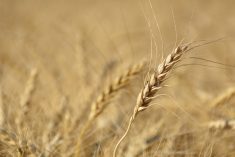New Alberta plant will increase delivery opportunities, but Bunge expansion plans are unclear
Alberta’s canola growers have a new processing plant, but the fate of another planned project is uncertain.
Cargill officially opened its second crush facility in Canada in Camrose last week.
“It is the first major investment in 30 years here in Alberta, so it’s a significant step forward,” said Jeff Vassart, president of Cargill Canada.
“It makes us the largest canola processor in Canada now.”
The grain industry giant has the capacity to crush 2.5 million tonnes of canola annually, with one million tonnes in Camrose and another 1.5 million tonnes at its plant in Clavet, Sask., which opened in 1996.
Read Also

Trump cuts off trade talks with Canada
UPDATED: October 24, 2025 – 0910 CST – Adds comments from Prime Minister Mark Carney. Reuters — U.S. President Donald…
To put that in perspective, Canada shipped 2.4 million tonnes of canola to Japan last year. The Asian country is one of Canada’s oldest and largest export markets.
However, even as Cargill celebrated the grand opening of its new plant, the fate of a planned expansion of Bunge’s facility in Fort Saskatchewan, Alta., is unknown.
Bunge refused to provide an update on the project, which was announced in September 2011.
A similar expansion project at Bunge’s facility in Altona, Man., that was announced in October 2010 was completed in the fall of 2014.
If there is an expansion taking place in Fort Saskatchewan, it is not obvious from the outside.
Phil Deobald, an agronomist with UFA Farm and Ranch Supply in Fort Saskatchewan, has driven by the plant numerous times.
“I haven’t seen anything going on there yet, and I haven’t heard any rumours or anything that they’re expanding,” he said.
Ward Toma, general manager of the Alberta Canola Producers Commission, has heard there have been some upgrades at Bunge’s Fort Saskatchewan plant but he has no idea whether that entailed a doubling of capacity.
He said Cargill’s Camrose facility is a real boon for the province’s canola growers.
“You’ve got another bidder. That’s always a good thing,” said Toma.
“You have another strong delivery point that’s not necessarily tied up by rail issues running into the Rockies.”
He said Camrose is a good location for the plant because it is in the middle of central Alberta where 40 percent of the canola crop is produced.
Toma said growers in east-central Alberta did not have a lot of delivery points for their canola.
“This will really help them with their options for delivery rather than being held captive to one point or maybe two points,” he said.
Patti Miller, president of the Canola Council of Canada, said Cargill’s Camrose investment helps move the industry toward its goal of crushing 14 million tonnes of canola domestically by 2025, up from 6.9 million tonnes so far this year with two weeks left in the 2014-15 crop year.
“It really is positioning the Canadian industry to be extremely competitive in the international market,” she said.
“I mean, we’ve got new, modern, efficient, sustainable plants. That’s going to stand us in really good stead.”
Most of the investment in canola processing over the last decade has occurred in Saskatchewan, where Cargill, Richardson International and Louis Dreyfus have spent hundreds of millions of dollars.
With the addition of Cargill’s Cam-rose plant, it won’t be long before Canada is crushing more canola than it exports.
Vassart said the Camrose facility has been buying canola since May, and the plant is already operating near full capacity.
It will produce 430,000 tonnes of oil and 570,000 tonnes of meal a year.
The unrefined oil will be shipped to export markets with an emphasis on meeting growing demand in Asia.
Vassart said the company has already developed a good customer base for the meal through its Clavet operation.
“We see consistently strong de-mand from a core group of customers that have increasing needs, and we’ll be able to meet them.”
Cargill chose Camrose for its crush facility because it is a good canola growing area and the company has experience working with farmers in the region with its seed export business.
“They do an excellent job of growing a significant amount of canola in this geography, and so for us it gives us a lot of confidence with the experience we’ve had with farmers here over the years,” said Vassart.
He expects growers will be pleased with unload times.
“It’s very efficient for farmers who are hauling here to be able to get on site, unload and leave within literally minutes.”
The facility will employ 60 permanent employees, many of them locals.
Vassart has concerns about this year’s canola crop, but he said it is a long way from being in the bin and recent rain has improved crop condition.
“It’s not going to be the bin buster we’ve had the last couple of years, but we feel that there still will be an adequate supply to be able to run the new facility here and maintain the export programs we’ve had historically,” he said.
The plant may be forced to extend its normal drawing radius of 200 to 250 kilometers to acquire enough feedstock to fuel its operations in 2015-16.
Vassart said there is potential for expansion at the Camrose facility.
He also said it may not be the last new plant Cargill builds in Canada, given the growing demand for canola oil and the canola council’s goal of growing 26 million tonnes by 2025.
“To say that it will be our final investment, I would say no,” he said.
















